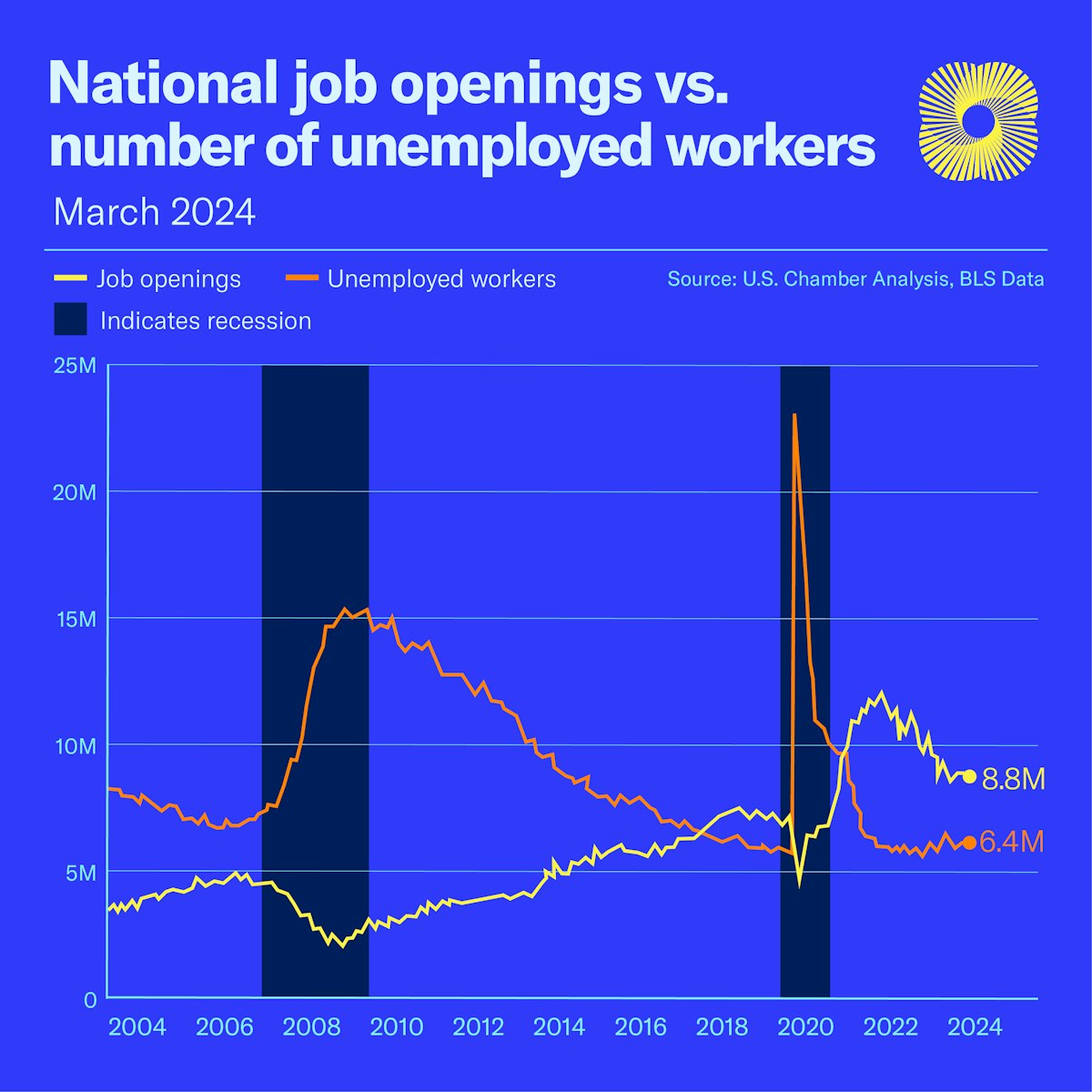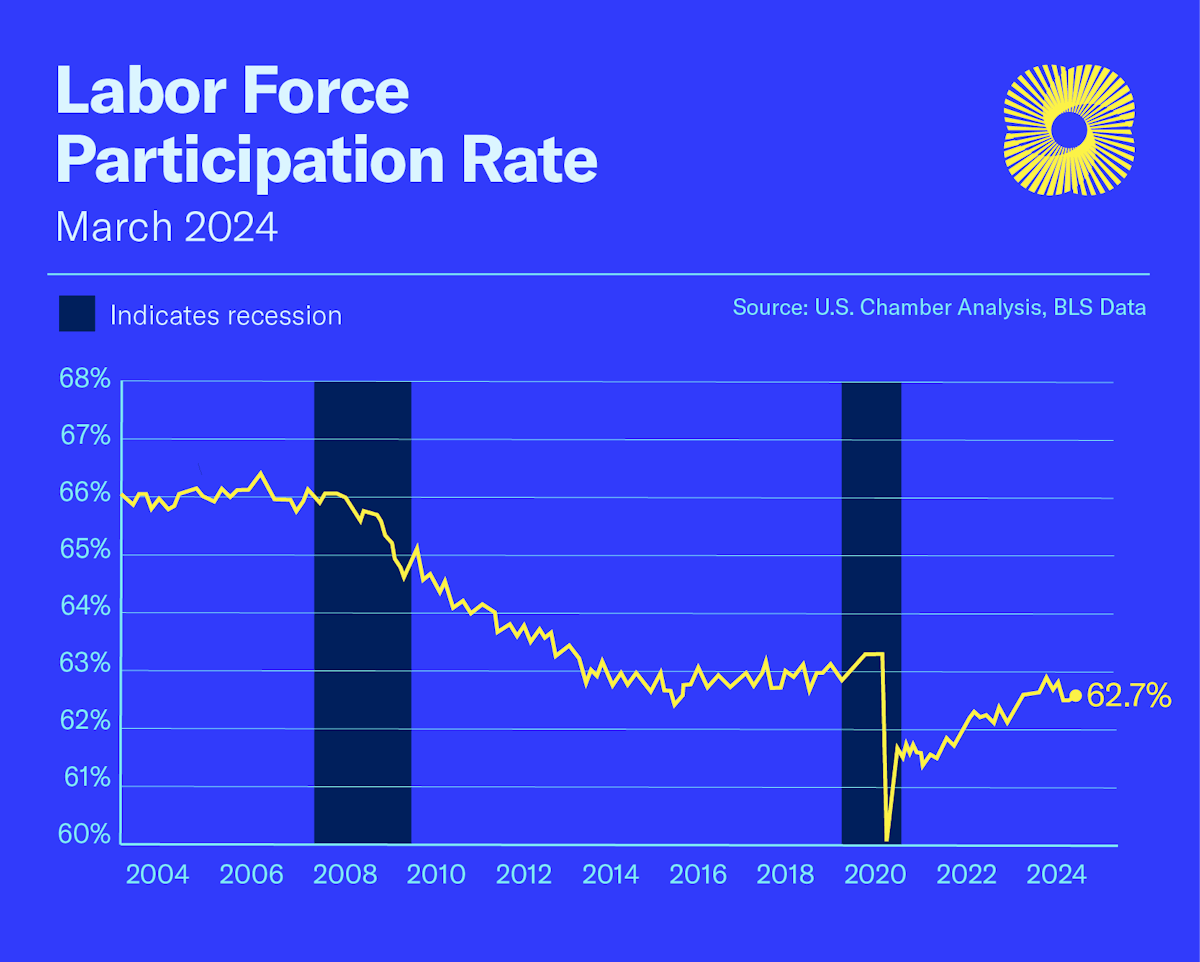
Sustainable Development Goals (SDGs) and the Worker Shortage in the U.S.
We hear every day from our member companies—of every size and industry, across nearly every state—that they’re facing unprecedented challenges trying to find enough workers to fill open jobs. Right now, the latest data shows that we have 8.8 million job openings in the U.S., but only 6.4 million unemployed workers.
Related
We have a lot of jobs but not enough workers to fill them. If every unemployed person in the country found a job, we would still have nearly 2.4 million open jobs.
The U.S. Chamber is capturing the trends on job openings, labor force participation, quit rates, and more, for a quick understanding of the state of the workforce in our America Works Data Center. Read on for an analysis of the state of the workforce on the national level.
Why are we in a worker shortage?
At the height of the pandemic, more than 120,000 businesses temporarily closed, and more than 30 million U.S. workers were unemployed. Since then, job openings have steadily increased while unemployment has slowly declined.

In 2023, employers ended up adding 3.1 million jobs. A strong jobs market is good news, but many of those job openings are going unfilled because the U.S. does not have enough workers to fill them. Even though we have more Americans participating in the workforce today than before the pandemic, the overall share of the population participating in the labor force has dropped. If our labor force participation rate today was the same as it was in February of 2020, we would have two million more Americans in our workforce to help fill those open jobs.
Stand Up for Free Enterprise
Join us and become a part of our movement to save the system that will secure our collective future.
Your voice is essential, and your participation is critical.
In fact, the decline of Americans’ labor force participation is nothing new—fewer and fewer Americans have been participating in the labor force for decades, resulting in a smaller workforce that is expected to continue shrinking for years to come.
Understanding the Gap
Right now, the labor force participation rate is 62.7%, down from 63.3% in February 2020 and 67.2% in January 2001. There’s not just one reason that workers are sitting out, but several factors have come together to cause the ongoing shortage. The factors detailed in the next section have all contributed to a labor shortage.

Additionally, in May 2022, the U.S. Chamber surveyed unemployed workers who lost their jobs during the pandemic to gain more insight into what is keeping them from returning to work. Here are a few of the key findings.
- Two-thirds (66%) of Americans who lost their full-time job during the pandemic say they are only somewhat active or not very active at all in searching for a new job.
- About half (49%) are not willing to take jobs that do not offer the opportunity for remote work.
- More than a quarter (26%) say it will never again be essential for them to return to work.
- Nearly one in five have altered their livelihood, 17% have retired, 19% have transitioned to homemaker, and 14% are now working part-time.
- Almost a quarter (24%) say government aid packages during the pandemic have incentivized them to not actively look for work.
- Younger respondents, aged 25-34, are prioritizing personal growth over searching for a job right now; 36% say they’re more focused on acquiring new skills, education, or training before re-entering the job market.
Factors Contributing to the Labor Shortage
SDGs, Targets, and Indicators Analysis
1. Which SDGs are addressed or connected to the issues highlighted in the article?
- SDG 8: Decent Work and Economic Growth
- SDG 5: Gender Equality
- SDG 4: Quality Education
- SDG 10: Reduced Inequalities
The article discusses the labor shortage and its impact on the workforce, which is directly related to SDG 8. SDG 5 is also relevant as it addresses gender equality in the workforce, which is mentioned in the article. Additionally, the article mentions the impact of the labor shortage on education and inequality, connecting to SDG 4 and SDG 10.
2. What specific targets under those SDGs can be identified based on the article’s content?
- Target 8.5: By 2030, achieve full and productive employment and decent work for all women and men, including for young people and persons with disabilities, and equal pay for work of equal value.
- Target 5.5: Ensure women’s full and effective participation and equal opportunities for leadership at all levels of decision-making in political, economic, and public life.
- Target 4.4: By 2030, substantially increase the number of youth and adults who have relevant skills, including technical and vocational skills, for employment, decent jobs, and entrepreneurship.
- Target 10.2: By 2030, empower and promote the social, economic, and political inclusion of all, irrespective of age, sex, disability, race, ethnicity, origin, religion, or economic or other status.
Based on the issues discussed in the article, these targets are relevant as they address the need for full employment, equal opportunities for women, skills development for employment, and social inclusion.
3. Are there any indicators mentioned or implied in the article that can be used to measure progress towards the identified targets?
- Labor force participation rate
- Unemployment rate
- Job openings
- Quit rates
- Access to childcare
- Retirement rates
- Net international migration
- Business starts
- Savings rate
The article mentions or implies several indicators that can be used to measure progress towards the identified targets. These indicators include labor force participation rate, unemployment rate, job openings, quit rates, access to childcare, retirement rates, net international migration, business starts, and savings rate.
SDGs, Targets, and Indicators Table
| SDGs | Targets | Indicators |
|---|---|---|
| SDG 8: Decent Work and Economic Growth | Target 8.5: By 2030, achieve full and productive employment and decent work for all women and men, including for young people and persons with disabilities, and equal pay for work of equal value. | Labor force participation rate, unemployment rate, job openings, quit rates |
| SDG 5: Gender Equality | Target 5.5: Ensure women’s full and effective participation and equal opportunities for leadership at all levels of decision-making in political, economic, and public life. | Labor force participation rate, access to childcare, retirement rates |
| SDG 4: Quality Education | Target 4.4: By 2030, substantially increase the number of youth and adults who have relevant skills, including technical and vocational skills, for employment, decent jobs, and entrepreneurship. | Skills development for employment |
| SDG 10: Reduced Inequalities | Target 10.2: By 2030, empower and promote the social, economic, and political inclusion of all, irrespective of age, sex, disability, race, ethnicity, origin, religion, or economic or other status. | Savings rate, net international migration |
Copyright: Dive into this article, curated with care by SDG Investors Inc. Our advanced AI technology searches through vast amounts of data to spotlight how we are all moving forward with the Sustainable Development Goals. While we own the rights to this content, we invite you to share it to help spread knowledge and spark action on the SDGs.
Fuente: uschamber.com

Join us, as fellow seekers of change, on a transformative journey at https://sdgtalks.ai/welcome, where you can become a member and actively contribute to shaping a brighter future.






